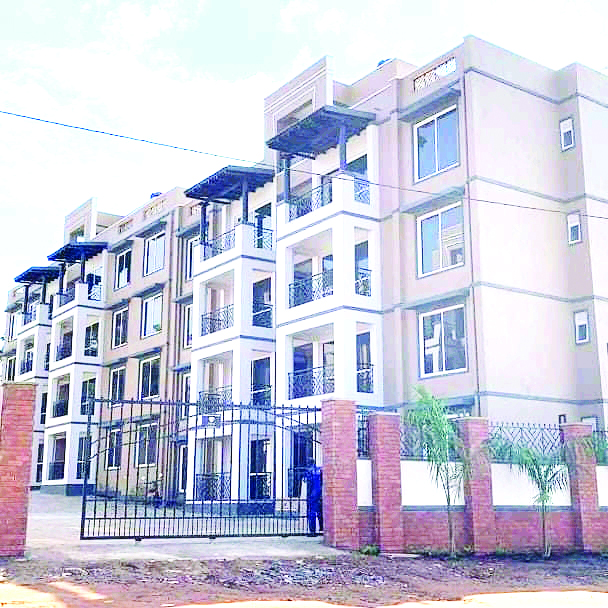By Michael Kanaabi
Rapid urbanisation and limited land for more housing units are influencing the demand for condominium units in the country.
According to Moses Ogaram, the CEO of BuyLet Uganda Limited, a real estate company, total investments in condominiums by developers stand at around USD 450 million (approximately Shs 1.62 trillion) currently. This figure, he adds, is set to rise as the demand for urban housing increases too.
He says: “The condo sub-sector currently commands about 29 per cent of the entire real estate. This is pushed by a steadily growing availability of affordable finance for both developers and condominium buyers, and Ugandans based overseas who prefer avoiding the hustle of construction from scratch.”

Why condominiums?
Condominiums (condos) are basically housing units or apartments built on top of each other on shared land, with each unit having an individual ownership title derived from the mother title of the piece of land.
According to Livingstone Mukasa, the CEO of Bitbricks Limited, an investor in the condominium subsector, the titles of individual condominium units usually mirror the original form of land ownership of the location they are built on.
In addition, condominium owners share common facilities like the internet, swimming pools, gyms plus other amenities, and for these, they usually pay retainer and maintenance fees to keep them effectively operational.
The move towards condominium ownership is picking up for a number of reasons; top among them being land for urban housing getting more scarce, according to Sonia Kantengwa, a Senior Sales Executive with Developer Fakhruddin Properties Uganda.
The other reason is the shift in tastes and preferences of home buyers to gated communities and ultra-modern apartment style homes.
On the developer’s side, the incentive is the unit cost of putting a condominium onto the market becomes less than that of would-be individual bungalows because of the shared costs of key amenities in the property.
What an investor needs
Mukasa says the first and most important aspect of any condominium is a good wrangle free land location.
You need to also have a good strategy of financing the development from the start of the project. You should also be able to produce quality homes in a timely manner because clients start booking and depositing money when the project takes shape.
Having a good marketing strategy is also critical to a successful condominium project, according to Kantengwa.
Partnerships with banks to finance the buyers’ side of the business is also critical to success, she adds.
Ideal requirements
Mukasa puts the minimum number of commercially viable condominium units at 10.
“Reason for this is to factor in the cost of land, for example if one buys a piece of land at Shs 300 million and puts up four units, the cost of land passed on will be about Shs 75 million per unit, which is large compared to if you put up at least 10 units, which would bring it down to Shs 30 million per unit; so, the higher the numbers, the better,” he says.
He adds that when it comes to the minimum capital, a developer should be looking at Shs 1 billion. He says that someone with less capital than that, is not likely to make it big in this space, given things like prime location and modern amenities are the selling point here and quite costly.
For those looking at large scale projects, Ogaram puts the ideal number of units at about 47, although he says this may not be standard given he has seen projects of about 27 units do quite well on the market.
However, he emphasises high -end condominiums bring in at least USD 1,500 (approximately Shs 5.4 million) per unit per month.
These bring in investors’ returns of about 8-15 per cent per unit. For a high-end condominium development, one should be looking at about USD 3.5 to 5 million on average.
The time it takes to get a full return on capital in the condominium sector starts from about 12 months for developers with good off project sales plans.
However, the average is about two to three years for a full return on investment, and a maximum five years for a project to be considered a success.
Downsides to condos
Like is the case with all businesses and home ownership, condominiums have their shortcomings, too.
Inadequate or no market research at all before project undertaking, unappealing living space design, lack of a proper sales strategy, choosing a poor location far away from key amenities like schools and hospitals, contractor shortfalls that prolong completion time shooting up costs are some of the downsides to the developer, according to Ogaram.
“The downsides for me as an entrepreneur are around the fact that it is a high pressure numbers game. As a result you need to have your costs and margins figured out even before you begin. Raising capital is also an issue and finally, being able to sell your units efficiently but an entrepreneur carrying all that risk is what makes you. If done well you will profit, if done poorly you could lose it all,” Mukasa says.
For Kantengwa, indecisive clients who book and retract, changing cost of materials during construction and natural calamities like Covid-19 can be big setbacks.
Uganda’s real estate sector, according to Ogaram, is worth about Shs 3.2 trillion in annual turnover, Shs 1.8 trillion of which are loans from banks.
This is a good indicator that financing is available for developers and buyers.
+++++++++++++++++++++++++++++++++++++++++
Subscribe to our website and be the first to receive great Christian news, health information, pastoral guidance, environment, farming and many others. Also, Like and follow us on Facebook at Good News UG.





















